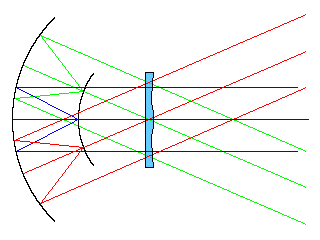
The Schmidt-Cassegrain telescope, which was mentioned earlier, combines the principle of a Cassegrain reflecting telescope with that of the original Schmidt camera. The illustration below shows how a Schmidt camera works:

This form of telescope used the symmetry of a spherical mirror, and a curved, spherical field of focus at which a curved photographic plate was placed, to allow a telescope with a very wide field to be constructed. The fact that the corrector plate, located at the center of these two concentric spheres, made the symmetry slightly less than perfect did not prevent it from giving good images.
To illustrate the principle, the diagram shows a very large focal field, which could not be fully used in practice, because a photographic plate at that location would block too much of the incoming light.
Note, though, that in the typical Schmidt-Cassegrain telescope, the corrector plate cannot be located at the center of curvature any longer, because the Cassegrain secondary is mounted directly on the corrector plate, which requires that the corrector plate be located closer to the mirror than the focus, which is at half the distance of the center of curvature.
The Maksutov design originally involved a similar symmetry principle:
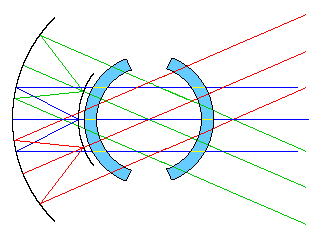
note that there are two possible positions for the corrector plate, both shown in this diagram, which preserve the symmetry.
In practice, of course, only one of the two meniscus correctors is present. However, one telescope design, often illustrated as having the form
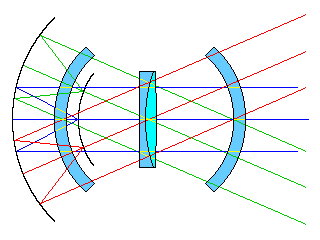
but also shown in this form in the original patent
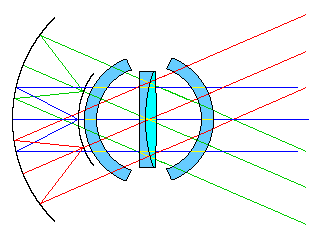
known as the Super-Schmidt telescope, actually includes two symmetrical meniscus correctors, as well as a doublet lens at the center of curvature of the primary mirror. The flint element of the doublet corrects for the chromatic aberration of all three crown components; as well, the doublet's spherical aberration supplies part of the correction needed by the spherical primary mirror, which is, presumably, the reason for not calling it a Super-Maksutov telescope. Splitting the correction in this fashion between the two meniscus correctors and the lens allows a very fast focal ratio to be achieved. This form of telescope was designed by Dr. James Baker in 1947, and was used for a system of specialized cameras used for taking photographs of meteors.
A variant, with only the rear meniscus present, also exists, known as the Meniscus-Schmidt camera.
Since the corrector plate of a Maksutov telescope, in the more common orientation, is closer to the mirror than the corrector plate in a Schmidt camera, yet Gregory-Maksutov telescopes tend to be longer than Schimdt-Cassegrain telescopes of similar aperture, this means that the mirrors in the Maksutov telescopes are less strongly curved, and therefore have less spherical aberration to correct. This is another reason for their superior optical quality. In addition, less of a compromise is required in regards to the overall symmetry of the basic Maksutov design for a Gregory-Maksutov telescope, although it is likely that some compromise is required, in order that the silvered area serving as the secondary mirror have enough curvature to function in an effective manner as a Cassegrain secondary.
One could have a Schmidt-Newtonian telescope, or a Schmidt-Gregorian telescope as well, of course.
Similarly, in addition to the type of Maksutov telescope shown above, which is a form of Maksutov-Cassegrain telescope, there are also Maksutov-Newtonian telescopes offered for sale.
The Schmidt camera, with the corrector plate at the primary mirror's center of curvature, requiring a curved film plate because of the spherical symmetry of the system preceded the Maksutov telescope, having been invented by Bernhard Schmidt in 1930. Albert Bouwers and Dimitri Maksutov both invented the symmetrical form of the telescope with a meniscus corrector during World War II. As described by Bouwers, the design had a meniscus whose surfaces were strictly concentric with the spherical primary mirror to minimize coma. It was Maksutov who originated the refinement of modifying the radii of the corrector to minimize chromatic aberration while coma is still kept low; this was an important refinement, as chromatic aberration is very visible and objectionable.
Due to the fact that this kind of telescope originated during World War II, there were in fact multiple independent inventions of it which took place. In addition to Maksutov, both Dennis Gabor and K. Penning took the step of going beyond the symmetric form in the same year.
An early catadioptric design by Hamilton from 1814 involved a thin objective lens made from crown glass, and a flint Mangin mirror; while this fully corrected for spherical aberration, it suffered from lateral color. However, modified versions including small corrector lenses relatively near the focus can produce well-corrected images.
The reason that the Schmidt camera became an important telescope type, and the Schmidt-Cassegrain telescope is popular and affordable, despite the need for a sophisticated aspheric corrector plate is because it happened that the aspheric surface needed for this kind of telescope could be very closely approximated by a simple and inexpensive method: take a thin, flat piece of glass, and put it on top of a round hole, behind which you pump out the air. This bends the glass slightly, and while the glass is thus bent, you grind a spherical surface on it in the normal manner. This process is illustrated by the diagram below:

A somewhat different technique, also using the deformation of glass under a difference in pressure, is illustrated in U.S. Patent 3,837,124 from 1973. This technique involves supporting the center of the glass plate. Because of that, while it is applicable to making a master for the production of corrector plates for Schmidt-Cassegrain telescopes, where the center of the corrector plate is removed, it would not have been the one originally used by Berhnhard Schmidt for making Schmidt cameras.
The Schmidt-Cassegrain telescope is an example of a catadioptric telescope, one that uses both mirrors and lenses. A refracting telescope, which uses lenses only, is called dioptric, and one which uses mirrors only (not counting the eyepiece) such as the Newtonian is called catoptric.
The fundamental types of reflecting telescopes are illustrated in the diagram below:
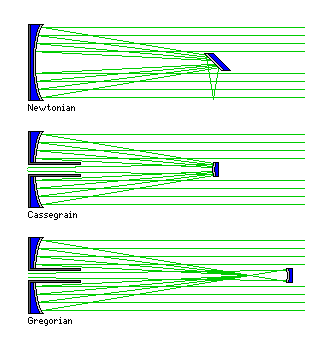
In each case, the primary mirror is ideally a paraboloid. In the Cassegrain, the secondary mirror should be a hyperboloid, and in the Gregorian, the secondary mirror should be an ellipsoid. However, there are modified versions of these designs that allow one element to have some spherical aberration, with the other element counterbalancing it.
In the case of the Cassegrain telescope, the possible forms are:
Copyright (c) 2001, 2002, 2006 John J. G. Savard